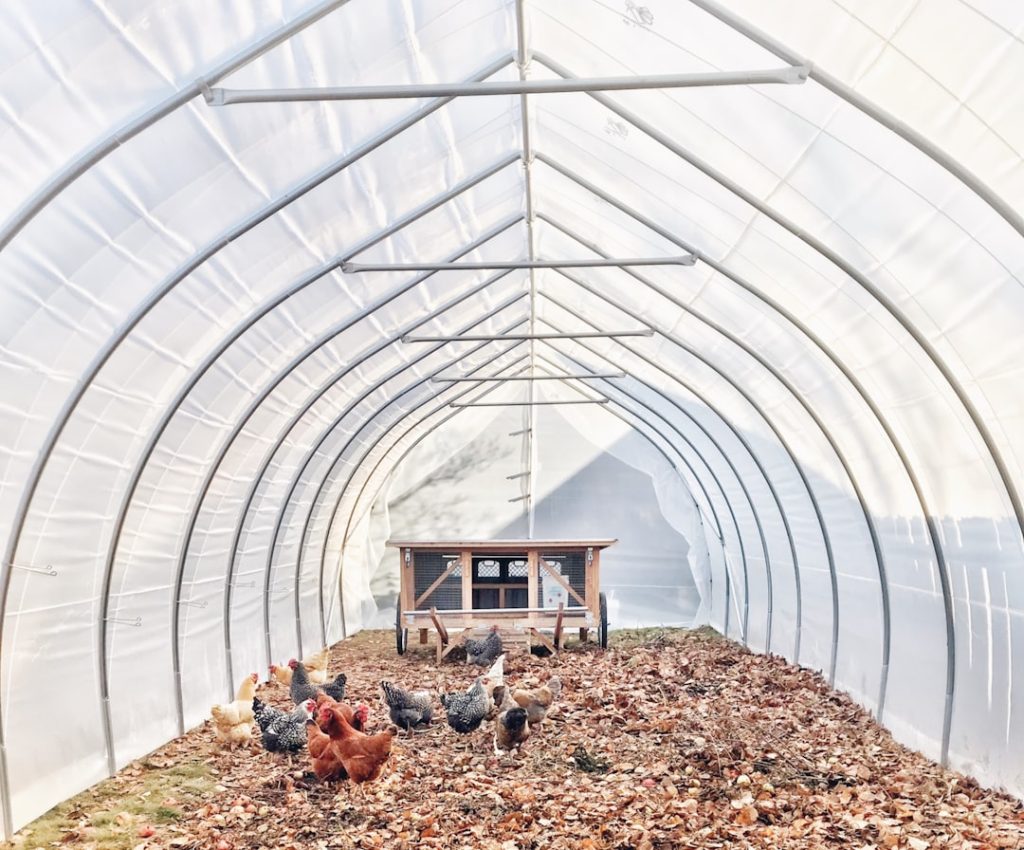Hawks are diurnal raptors renowned for their exceptional vision and hunting prowess. They typically inhabit open landscapes such as fields, meadows, and forests, where they can easily locate prey from afar. Their diet primarily consists of small mammals, birds, and reptiles, making chickens an appealing target.
Comprehending hawk behavior is essential for developing effective chicken protection strategies. As diurnal birds, hawks are most active during daylight hours. Their superior eyesight allows them to spot prey from great heights, while their speed and agility enable precise attacks.
It is crucial to note that hawks are protected under the Migratory Bird Treaty Act, making it illegal to harm or kill them without proper authorization. Consequently, non-lethal deterrent methods are necessary for safeguarding chickens from hawk predation. By studying hawk behavior, chicken owners can anticipate hunting patterns and implement proactive measures to protect their flocks.
Understanding these predators’ habits and tendencies allows for the creation of a secure environment that minimizes the risk of hawk attacks on chickens.
Table of Contents
- 1 Creating a Secure Chicken Coop
- 2 Using Deterrents to Keep Hawks Away
- 3 Providing Alternative Food Sources for Hawks
- 4 Supervising Free-Range Time for Chickens
- 5 Implementing Sound and Visual Distractions
- 6 Seeking Professional Help if Necessary
- 7 FAQs
- 7.1 What are some effective methods for keeping hawks away from young chickens?
- 7.2 Are there any natural deterrents that can be used to keep hawks away from young chickens?
- 7.3 What should I do if I spot a hawk near my chicken coop?
- 7.4 Are there any legal methods for deterring hawks from preying on young chickens?
- 7.5 What are some signs that a hawk may be targeting young chickens in my area?
Key Takeaways
- Hawks are opportunistic predators and will target chickens as a food source
- Secure chicken coops with sturdy fencing and a roof to prevent hawk attacks
- Use visual deterrents such as scarecrows or reflective tape to keep hawks away
- Provide alternative food sources such as bird feeders to distract hawks from chickens
- Supervise free-range time for chickens to ensure their safety from hawk attacks
- Implement sound and visual distractions such as wind chimes or hanging CDs to deter hawks
- Seek professional help from wildlife experts if hawk attacks persist
Creating a Secure Chicken Coop
Designing a Secure Chicken Coop
One of the most effective ways to protect your chickens from hawk attacks is to create a secure chicken coop. A well-designed coop can provide a safe and sheltered environment for your chickens, reducing their vulnerability to predators such as hawks. When building a chicken coop, it’s important to consider factors such as size, materials, and security features to ensure the safety of your flock.
Key Considerations for Coop Design
The size of the coop is an important consideration, as it should provide enough space for your chickens to move around comfortably while also offering protection from predators. The coop should be constructed using sturdy materials such as wood or metal to withstand potential attacks from hawks. Additionally, it’s essential to install secure latches and locks on doors and windows to prevent unauthorized entry by predators.
Securing the Surrounding Area
In addition to the physical structure of the coop, it’s important to consider the surrounding area. Clearing away any tall trees or structures that hawks could use as perches near the coop can help reduce the risk of attacks. By creating a secure chicken coop and surrounding area, you can provide your chickens with a safe and protected environment where they can roost, lay eggs, and forage without the constant threat of hawk predation.
Using Deterrents to Keep Hawks Away

Deterrents can be an effective way to keep hawks away from your chicken coop and reduce the risk of attacks on your flock. There are several non-lethal methods that can be used to deter hawks and discourage them from preying on your chickens. By implementing these deterrents, you can create a hostile environment for hawks and minimize the likelihood of them targeting your flock.
One common deterrent is the use of visual deterrents such as scarecrows, reflective tape, or shiny objects that can startle and deter hawks from approaching the coop. These visual deterrents can disrupt the hunting patterns of hawks and make them think twice before attempting to attack your chickens. Another effective method is the use of sound deterrents such as wind chimes, bells, or predator calls that can create a noisy and unsettling environment for hawks.
In addition to visual and sound deterrents, you can also consider using motion-activated devices such as sprinklers or lights to startle hawks when they approach the coop. These devices can be effective in deterring hawks and preventing them from targeting your chickens. By using a combination of visual, sound, and motion-activated deterrents, you can create an environment that is unappealing to hawks and reduce the risk of attacks on your flock.
Providing Alternative Food Sources for Hawks
Another strategy for protecting your chickens from hawk attacks is to provide alternative food sources for hawks in the vicinity of your property. By offering alternative prey for hawks, you can reduce their incentive to target your chickens as a food source. This can help create a more balanced ecosystem and minimize the risk of hawk attacks on your flock.
One way to provide alternative food sources for hawks is by setting up bird feeders or feeding stations with seeds or suet that can attract small birds and other prey that hawks typically feed on. By offering these alternative food sources, you can help divert the attention of hawks away from your chickens and reduce the likelihood of them hunting in your immediate area. Additionally, providing habitat for small mammals such as mice or voles can also help create alternative food sources for hawks.
It’s important to note that providing alternative food sources for hawks should be done in a strategic manner to avoid attracting more predators to your property. By carefully managing the placement and type of alternative food sources, you can help create a more balanced ecosystem that reduces the risk of hawk attacks on your chickens. By providing alternative food sources for hawks, you can help minimize their reliance on your chickens as a primary food source and reduce the likelihood of attacks on your flock.
Supervising Free-Range Time for Chickens
Allowing your chickens to free-range can provide numerous benefits such as access to fresh grass, insects, and natural sunlight. However, it also exposes them to potential predators such as hawks. To protect your free-ranging chickens from hawk attacks, it’s important to supervise their outdoor activities and implement measures to minimize the risk of predation.
Supervising free-range time for chickens involves keeping a close eye on your flock while they are outside the coop. By regularly checking on your chickens and being present in the outdoor area, you can deter hawks from approaching and reduce the likelihood of attacks. Additionally, supervising free-range time allows you to quickly intervene if you notice any signs of potential danger from predators.
In addition to direct supervision, you can also consider using temporary fencing or netting to create a protected area for your free-ranging chickens. This can help create a physical barrier that deters hawks from swooping down on your flock while still allowing them to enjoy some freedom outdoors. By supervising free-range time for your chickens and implementing protective measures, you can provide them with the opportunity to roam while minimizing the risk of hawk attacks.
Implementing Sound and Visual Distractions

Sound Distractions
One effective method is the use of predator calls or distress calls that mimic the sounds of other birds or animals in distress. These calls can startle hawks and make them think twice before approaching your property. Additionally, using noise-making devices such as air horns or whistles at regular intervals can create a disruptive environment that deters hawks from hunting in the area.
Visual Deterrents
In addition to sound distractions, visual deterrents such as hanging shiny objects or flags around the coop can help disrupt the hunting patterns of hawks. These visual distractions can make it more difficult for hawks to focus on their prey and reduce their likelihood of targeting your chickens.
Creating an Unappealing Environment
By implementing sound and visual distractions, you can create an environment that is unappealing to hawks and minimize the risk of attacks on your flock.
Seeking Professional Help if Necessary
If despite all efforts hawk attacks continue to pose a threat to your chickens, it may be necessary to seek professional help. Wildlife experts or bird control specialists can provide valuable insight and assistance in developing effective strategies to deter hawks and protect your flock. These professionals have experience in dealing with predatory birds and can offer guidance on implementing advanced deterrent methods.
Professional help may involve conducting a thorough assessment of your property to identify potential vulnerabilities and develop a customized plan to deter hawks. They may also recommend advanced deterrent devices or techniques that are specifically designed to deter predatory birds such as hawks. Additionally, wildlife experts can provide advice on legal considerations related to deterring hawks while ensuring compliance with regulations protecting migratory birds.
In some cases, professional help may also involve obtaining permits for certain deterrent methods or seeking assistance from local wildlife authorities in managing hawk populations in the area. By seeking professional help if necessary, you can gain access to specialized knowledge and resources that can help effectively address hawk predation and protect your chickens from attacks.
If you’re looking for tips on how to keep a hawk from eating young chickens, you may also be interested in learning about the best location for your chicken coop. Check out this article on where to put your chicken coop for helpful advice on keeping your chickens safe and secure.
FAQs
What are some effective methods for keeping hawks away from young chickens?
Some effective methods for keeping hawks away from young chickens include using netting or wire mesh to cover the chicken coop, installing scare devices such as reflective tape or predator decoys, and providing overhead cover for the chickens to hide under.
Are there any natural deterrents that can be used to keep hawks away from young chickens?
Some natural deterrents that can be used to keep hawks away from young chickens include planting tall trees or shrubs around the chicken coop to provide cover for the chickens, and allowing larger birds such as roosters or turkeys to roam with the chickens to provide protection.
What should I do if I spot a hawk near my chicken coop?
If you spot a hawk near your chicken coop, you should immediately take action to scare it away. This can be done by making loud noises, using scare devices such as reflective tape or predator decoys, or even physically chasing the hawk away.
Are there any legal methods for deterring hawks from preying on young chickens?
In the United States, hawks are protected under the Migratory Bird Treaty Act, which makes it illegal to harm, harass, or kill them without a special permit. Therefore, it is important to use non-lethal and humane methods for deterring hawks from preying on young chickens.
What are some signs that a hawk may be targeting young chickens in my area?
Some signs that a hawk may be targeting young chickens in your area include finding feathers or remains of chickens near the coop, observing a hawk circling or perching near the coop, or noticing a decrease in the number of chickens in your flock.
Meet Walter, the feathered-friend fanatic of Florida! Nestled in the sunshine state, Walter struts through life with his feathered companions, clucking his way to happiness. With a coop that’s fancier than a five-star hotel, he’s the Don Juan of the chicken world. When he’s not teaching his hens to do the cha-cha, you’ll find him in a heated debate with his prized rooster, Sir Clucks-a-Lot. Walter’s poultry passion is no yolk; he’s the sunny-side-up guy you never knew you needed in your flock of friends!







